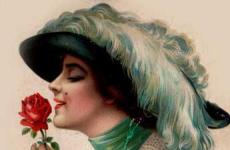We draw birch trees with watercolors. Autumn birch in gouache step by step. Master class with photo Birch in autumn watercolor
Description of the drawing process:
In this video I'll show you how to paint a winter landscape using just three colors, a few brushes and, most interestingly, a plastic card.
In this sketch I will use three colors: ocher, blue and dark brown.
I start from the background, carefully evenly moistening half of the picture. I mix a light shade of gray and fill the moistened half of the sheet with it. Now I introduce the trees in the background, for this I complicate the blue a little with brown. I wait about one minute and then, holding the card at a slight angle, scribble down the light areas of the trunks and branches. This can be done with both vertical and transverse movements to the trunk. I dry this layer slightly in order to apply the dark areas of the birch trees. If you mix blue with brown, you get a rather complex shade of dark gray. I type this color with the edge of the card. I start from the bottom of the birches. Sliding easily along the trunk with movements transverse to the trunk, I get black marks on the birches.
I wet the part where the stream flows. Now I introduce a gray-blue into the water of the stream, and then add a darker one where I have reflections of the black marks of the birch trunks and the edge adjacent to the snow cover. Now all that remains is to write the branches. Birch branches vary depending on its type. Those branches that are further from us, behind the tree, have a lighter bluish tint. Those branches that are closer to us are warm brown and darker.
And here the work could be completed, but I will go a little further to show you a more artistic move. I completely dried the picture and now I can apply the second layer. I take ocher and make the birch trunks a little warmer. We have a third color and a more interesting flavor.
And now I will add last year's grass, for this I will use a very interesting card trick. I make a drop of paint and pull out the paint with jerky movements to make grass. You can mix it a little with blue to get more interesting, varied shades.
Now we give a little volume to the snowdrifts. To do this, I give a shadow color along the snowy edge of the stream and under the blades of grass, too, to create depressions, like near the trees. And after seeing where something else can be added in the composition, we add darker areas of snow or protruding branches to complete the image.
To draw any type of tree, we use the same type of drawing technique, which allows us to quickly and realistically depict all parts of the plant. But each type of tree has its own unique structure, which distinguishes it from others. And you need to be able to convey these features in a drawing. In this lesson we will show you how to draw a birch tree in watercolor step by step. The main features of birch trees are straight white trunks with dark stripes, thin drooping branches and small foliage. We will draw from a picture, but if you have the opportunity, go plein air. After all, drawing from life helps not only to form a vision of the color and tonality of an object, but also the ability to analyze the composition.
To draw this tree you will need some tools:
- watercolor paints;
- palette;
- tablet;
- adhesive tape (stationery or masking tape);
- squirrel brushes No. 8 and 1;
- synthetic brush No. 1;
- hard pencil;
- eraser;
- watercolor paper;
- water;
- napkins.

Drawing stages
Step 1. Let's make the sketch light, without overloading details. First, mark the horizon line. In the center we draw straight thin trunks of birch trees. Starting from the middle of the trunks, we create thin drooping branches. Smooth lines indicate the approximate contour of the tree crown. 
This sketch is enough to move on to the next step.
Step 2. Using a thin brush No. 1 and sepia, we create a texture on the white birch trunks. Based on the sketch, we mark the largest branches in the crown. The lower part of the trunks is shaded with a denser color - gas soot. 
Step 3. Use cadmium yellow medium to create an underpainting of the grass. Using a wet layer of paint, shade it green. 
Step 4. While the paint is absorbing, mark the light parts of the crown with lemon watercolor. Let's go back to the grass and use a mixture of green and sepia to create a shadow falling from the trees. 
Step 5. We begin to draw the crowns of the birch trees from the center, where we use rich dark shades of green. Moving to the edge of the crown, we partially wash off the paint from the brush to make the tone more transparent. Also, when processing the edge, we reduce the size of the stroke to create the effect of individual leaves. 
Step 6. Gradually work out the entire surface of the wood, following the tone sketch. We draw thin drooping branches along the edge to convey the structure of the birch crowns. Afterwards we saturate the grass and falling shadows under the trees. 

Step 7. In the last step we will work with the splashes. Thanks to this technique of applying paint, we will create beautiful effects of small foliage along the contour of the crowns and a flowering lawn under the trees. First, we process the tree tops (crowns) with yellow-green watercolors. 
We have already tried drawing on wet paper in previous lessons. Now I want to tell you a few more simple techniques in watercolor. This lesson is for those who are just starting their journey in mastering watercolor paints. It is very simple and, if desired, anyone can do it.
First, as before, let's try to make the background. To do this, attach a sheet of watercolor paper to the tablet and place it at an angle so that the watercolor flows beautifully and spreads across the paper.
The sheet must be moistened with water. This can be done with a brush (clean) or a sponge. We make several rich strokes on the wet paper. The paint will flow down and dissolve smoothly.
To make clouds, take a napkin and blot the paint in the right places. Do not rub the paint, do not rub the napkin on the paper - just gently blot it and that’s it.

These are the clouds we got.

Now, while the paper is still wet, let's draw a brush with a rich color under the clouds. You can draw not a straight line, but a slightly uneven one, so that you get the far bank.

Background. In order to draw the trunks of birch trees, we will use a small piece of plastic. You can take an old used card and use it to remove a layer of paint in the thickest place with a sharp movement.
You can practice first on a separate piece of paper. Do not create puddles on the sheet - then everything will work out. If the sheet of paper is in an inclined position, then there will be no puddles.

Draw the birch trunks. You can add dark lines to the distant forest - let it be a mixed forest, not just birch.

Lastly, in the middle and foreground, transparently, so as not to frighten off the charm of the cold morning, we will draw trees and branches inclined almost to the water.
Thin, slender birch has always been a symbol of beauty and shyness. This beautiful and healthy tree produces delicious sweet juice, is very graceful and a pleasure to draw. Birch is especially magnificent in summer, when lush foliage and birch “catkins” appear. Be sure to make a few sketches in nature with a simple pencil, watercolor or watercolor pencils, crayons and watch how the wind sways its thin branches, how the shiny carved leaves shimmer in the sun, touch the warm trunk. Now let's try to draw a birch tree in watercolors.
How to draw a birch tree step by step?- Take a thick sheet of A4 size watercolor paper. We draw on its rough side, not on the smooth side. You will also need a hard, sharply sharpened pencil. You just don’t need to try to make the lead as sharp as a needle, it will scratch the surface of the paper and watercolor paint getting into these scratches will eat in firmly and they will all be very noticeable in the drawing. We make a light sketch of the future birch tree with a pencil. Its features are a thin trunk and flexible branches that bend under the weight of the foliage. The leaves are small, so we will depict them only as a hint, without drawing them carefully.

- We outline with a pencil the areas where the birch foliage will be. Since it is small, from a distance it will seem that it is a dense volumetric mass. The areas are uneven, in some places some of the branches go down, in others they lie in an even layer, especially at the top. The birch foliage descends as if in a cascade or a large green waterfall.

- Now watercolor comes into use, and let's try to paint a birch tree with paints. Use transparent green-yellow paint to paint the surfaces where the foliage will be. We outline the sky with a gentle blue - the darkest paint will be on top, and the lightest below. We make a smooth gradient transition, adding more water, we get a gentle summer sky. We designate the grass under the tree.

- We enhance the color of the sky, you can add either warm violet or cold blue, outline the shadows. Each branch is like a large bunch, it has volume. Since the sunlight comes at an angle from above, there will be shadow at the bottom. We do not completely paint over the surface, but as if we were making light strokes with a brush, indicating small clusters of birch leaves. In the lightest areas, the leaves can be drawn with small dashes or dots, just outline them.

- In the shadows, add more dark to give the foliage volume. Notice how the layers of paint overlap - with slight indentations. First came the lightest layer of watercolor, then a little darker and the last one was the darkest. You can make another one, darker than the previous one and also draw it with a slight indentation. We draw the leaves with dots or small “droplets”. Look at how the birch leaves are arranged.

- We draw a birch trunk and its branches. Using a thin brush, paint small dark stripes on the trunk. Please note that they are very different and uneven - some are small, some are larger. It is better to take not thick black watercolor, but blue and red, to get a rich brown color with a cool tint. Some of the birch branches are hidden by foliage, so do not draw solid lines, make them intermittent. This is especially noticeable in the figure in the lower branch on the left. We draw hanging thin branches. Make a shadow under the branches - brown paint + blue or light blue. The branches near the trunk will be darker. Add blue to the sky, you can leave spots and stains, they look like clouds. Below at the base of the tree we will enhance the shadow - green + blue.

- We complete the drawing. Using a thin brush we work out the details, enhancing the shadows for contrast on the branches, tree trunk and on the ground. Pure black paint should not be used, it will look rather rough. It is better to take a combination of dark blue and red or dilute black with blue watercolors.


Before you draw a tree for your child step by step, you need to carefully study these natural objects and find similarities between them.
What does any, well, almost any tree have? The answer suggests itself - a straight and powerful trunk. As a rule, from below it is quite thick and voluminous, but the closer to the top of the tree, the thinner it becomes. It is from the trunk that branches go in all directions, while the main ones rush upward.
Closer to the base, the branches are long, and towards the top, on the contrary, they are short. From large skeletal branches smaller branches grow in different directions, from them even smaller ones, etc. The crown of almost all trees directly depends and is formed from such branches. Considering all these facts, you can easily draw the “skeleton” of a tree.
Important: you can depict trees in winter in a similar way - just branches, without foliage. 
Interested? Then let's look in more detail at how to draw a tree with a pencil step by step for children. Believe me, it will be very educational and also interesting.
How to draw a tree: general diagram
First of all, let’s decorate the “skeleton” of the tree with leaves. You can create them with simple dots, making a leafy crown from individual dots (Figure A). As for coloring, for a summer tree it is better to use several shades of yellow or green; the autumn version can be done using red, yellow, orange or green paints.
In addition, most children can easily depict a certain plane with an irregular, oval-like shape (Figure B). This method is ideal for teaching drawing to kids. Drawing trees in a landscape will also be useful in this case. First draw one trunk and skeletal thick branches. Now paint over the green part of the tree and add small branches. 
Foliage image options
As mentioned above, we draw a tree “in principle,” that is, an image familiar to most of us. Naturally, in nature, different types of trees differ significantly from each other. In our drawing there will also be a difference in the trunks: a powerful and thick giant oak, pine or rowan, a weeping slender birch with drooping branches. What exactly to depict is up to you.

Simple tree: drawing lesson for children from 4 years old
This is actually a very easy but fun way to draw a tree. Of course, it is impossible to determine its type. Yes, this is not required here. The main thing is that we know for sure that the tree is deciduous.
1. Together with your child, draw a trunk and several voluminous, large branches. The foliage must be made in the shape of an oval.
2. Color your drawing with colored pencils, markers or paints. Everything depends only on your imagination. 
At first glance, it seems that such a drawing is very simple and ordinary, however, it provides rich soil for creativity and allows you to embody the most original ideas. Take a close look at the picture below and see for yourself what variety of trees you can draw using this technique. 
Oak - step-by-step execution with children from 6 years old
This oak is somewhat reminiscent of an ordinary tree, which we have already considered. However, there are much more individual details: complex branches, bark texture and hollow. Don't worry if your child makes the lesson easier or misses something. The main goal is for the tree to be powerful and stocky. 
We draw a birch tree with children from 8 years old step by step
For many children, drawing such a tree is a difficult task. Why? Here everything is as close as possible to a realistic image, there are complex lines and details. Therefore, you should not draw a birch for preschoolers, as well as those who study in primary school. Most likely they will try to simplify the drawing. 
Draw your child's attention to the birch branches - they are leaning down!
Pine: step-by-step implementation with children from 8 years old
Now let's leave deciduous trees and move on to conifers. Tell your children, if they don't already know, that the pine tree is an evergreen tree. Therefore, it makes no difference what time of year you paint it: summer or winter - the crown is always the same. To draw pine trees, the same principle is used as for deciduous trees. The only difference is that the green needle spots must be clearly connected to the branches. In addition, unlike deciduous trees, this tree has a more voluminous “bare” part of the trunk. 
Christmas tree - a simple drawing diagram for children from 4 years old
You can draw another, no less popular and well-known coniferous tree, a Christmas tree, in several ways. But we will consider only one - a coniferous and very realistic tree for adult children. You can see the drawing in the picture below. 
And now an unusual option - we draw a palm tree with children from 7 years old
So, earlier we learned how to draw trees that grow in our country. Now it's time for more exotic plants. For example, it is very interesting to draw a palm tree - a decorative, simple, but at the same time, original tree. Translated from Latin, palm means “palm” - “palma”. Apparently this is due to the palm leaves spread out like “fingers”.
We will present two main options for drawing this tree: the first is a more realistic image, the second is, one might say, “cartoonish.” The difficulty of completing both drawings is approximately the same. Children from 7 to 8 years old can easily cope with this task, of course, not without the help of their parents.
Option No. 1 - a diagram of drawing a palm tree with children from 7 years old in several steps. 
Option No. 2 
Well, that's all. Now you have personally seen that drawing a tree is easy. And it doesn’t matter what exactly you want to depict: oak, birch, palm tree, etc. The main thing is to believe in your own strength and, of course, show a little imagination. Below we provide additional materials.






